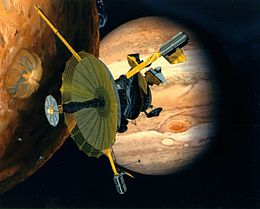 Global Information
Global InformationGalileo project information
 Artist's concept of Galileo at Io with Jupiter in the background. The high-gain antenna is fully deployed in this illustration but in reality the antenna failed to extend. | |||||||||||||||||||||||
| Names | Jupiter Orbiter Probe | ||||||||||||||||||||||
|---|---|---|---|---|---|---|---|---|---|---|---|---|---|---|---|---|---|---|---|---|---|---|---|
| Mission type | Jupiter orbiter | ||||||||||||||||||||||
| Operator | NASA | ||||||||||||||||||||||
| COSPAR ID | 1989-084B | ||||||||||||||||||||||
| SATCAT no. | 20298 | ||||||||||||||||||||||
| Website | solarsystem | ||||||||||||||||||||||
| Mission duration |
| ||||||||||||||||||||||
| Distance travelled | 4,631,778,000 km (2.88 billion mi)[1] | ||||||||||||||||||||||
| Spacecraft properties | |||||||||||||||||||||||
| Manufacturer |
| ||||||||||||||||||||||
| Launch mass |
| ||||||||||||||||||||||
| Dry mass |
| ||||||||||||||||||||||
| Payload mass |
| ||||||||||||||||||||||
| Power |
| ||||||||||||||||||||||
| Start of mission | |||||||||||||||||||||||
| Launch date | October 18, 1989, 16:53:40 UTC[3] | ||||||||||||||||||||||
| Rocket | Space Shuttle Atlantis STS-34/IUS | ||||||||||||||||||||||
| Launch site | Kennedy LC-39B | ||||||||||||||||||||||
| Entered service | December 8, 1995, 01:16 UTC SCET | ||||||||||||||||||||||
| End of mission | |||||||||||||||||||||||
| Disposal | Controlled entry into Jupiter | ||||||||||||||||||||||
| Decay date | September 21, 2003, 18:57:18 UTC | ||||||||||||||||||||||
| Flyby of Venus (gravity assist) | |||||||||||||||||||||||
| Closest approach | February 10, 1990[4] | ||||||||||||||||||||||
| Distance | 16,000 kilometers (9,900 mi) | ||||||||||||||||||||||
| Flyby of Earth (gravity assist) | |||||||||||||||||||||||
| Closest approach | December 8, 1990 and December 8, 1992 | ||||||||||||||||||||||
| Distance | 960 kilometers (600 mi) and 303 kilometers (188 mi) | ||||||||||||||||||||||
| Flyby of 951 Gaspra | |||||||||||||||||||||||
| Closest approach | October 29, 1991 | ||||||||||||||||||||||
| Distance | 1,601 kilometers (995 mi) | ||||||||||||||||||||||
| Flyby of 243 Ida | |||||||||||||||||||||||
| Closest approach | August 28, 1993 | ||||||||||||||||||||||
| Distance | 2,400 kilometers (1,500 mi) | ||||||||||||||||||||||
| Jupiter orbiter | |||||||||||||||||||||||
| Spacecraft component | Orbiter | ||||||||||||||||||||||
| Orbital insertion | December 8, 1995, 01:16 UTC SCET | ||||||||||||||||||||||
| Jupiter atmospheric probe | |||||||||||||||||||||||
| Spacecraft component | Probe | ||||||||||||||||||||||
| Atmospheric entry | December 7, 1995, 22:04 UTC SCET[5] | ||||||||||||||||||||||
| Impact site | 06°05′N 04°04′W / 6.083°N 4.067°W at entry interface | ||||||||||||||||||||||
| |||||||||||||||||||||||

NASA Flagship Program | |||||||||||||||||||||||
Galileo was an American robotic space program that studied the planet Jupiter and its moons, as well as several other Solar System bodies. Named after the Italian astronomer Galileo Galilei, the Galileo spacecraft consisted of an orbiter and an atmospheric entry probe. It was delivered into Earth orbit on October 18, 1989, by Space Shuttle Atlantis on the STS-34 mission, and arrived at Jupiter on December 7, 1995, after gravity assist flybys of Venus and Earth, and became the first spacecraft to orbit Jupiter. The spacecraft then launched the first probe to directly measure its atmosphere. Despite suffering major antenna problems, Galileo achieved the first asteroid flyby, of 951 Gaspra, and discovered the first asteroid moon, Dactyl, around 243 Ida. In 1994, Galileo observed Comet Shoemaker–Levy 9's collision with Jupiter.
Jupiter's atmospheric composition and ammonia clouds were recorded, as were Io's volcanism and plasma interactions with Jupiter's atmosphere. The data Galileo collected supported the theory of a liquid ocean under the icy surface of Europa, and there were indications of similar liquid-saltwater layers under the surfaces of Ganymede and Callisto. Ganymede was shown to possess a magnetic field and the spacecraft found new evidence for exospheres around Europa, Ganymede, and Callisto. Galileo also discovered that Jupiter's faint ring system consists of dust from impacts on the four small inner moons. The extent and structure of Jupiter's magnetosphere was also mapped.
The primary mission concluded on December 7, 1997, but the Galileo orbiter commenced an extended mission known as the Galileo Europa Mission (GEM), which ran until December 31, 1999. By the time GEM ended, most of the spacecraft was operating well beyond its original design specifications, having absorbed three times the radiation exposure that it had been built to withstand. Many of the instruments were no longer operating at peak performance, but were still functional, so a second extension, the Galileo Millennium Mission (GMM) was authorized. On September 20, 2003, after 14 years in space and 8 years in the Jovian system, Galileo's mission was terminated by sending it into Jupiter's atmosphere at a speed of over 48 kilometers per second (30 mi/s) to eliminate the possibility of contaminating the moons with terrestrial bacteria.
- ^ "The Final Day on Galileo – Sunday, September 21, 2003". Spaceref.com. September 19, 2003. Retrieved August 11, 2023.
- ^ a b c d e f g h i j k l m "Galileo Jupiter Arrival" (PDF) (Press Kit). NASA/Jet Propulsion Laboratory. December 1995.
- ^ Beyer, P. E.; O'Connor, R. C.; Mudgway, D. J. (May 15, 1992). "Galileo Early Cruise, Including Venus, First Earth, and Gaspra Encounters" (PDF). The Telecommunications and Data Acquisition Report. NASA/Jet Propulsion Laboratory: 265–281. TDA Progress Report 42-109.
- ^ "Welcome to the Galileo Orbiter Archive Page". PDS Atmospheres Node. October 18, 1989. Retrieved April 11, 2023.
- ^ Michael Meltzer, Mission to Jupiter: a History of the Galileo Project, NASA SP 2007–4231, p. 188